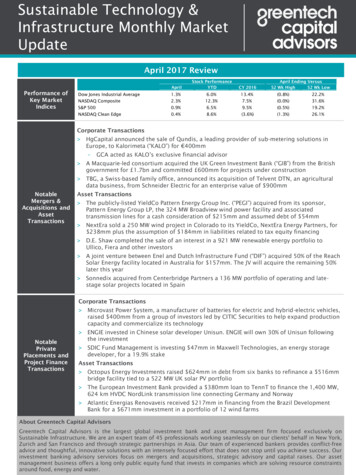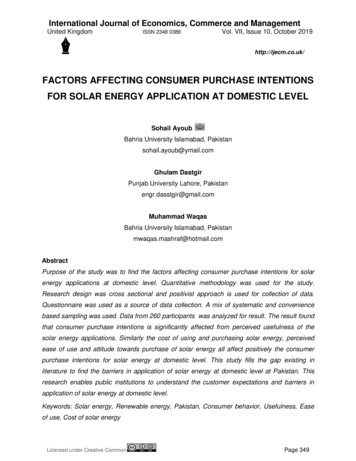
Transcription
Solar Energy Systems for Small Commercial BusinessesGuide to Assessing, Investigating, and ContractingPrepared for:The Minneapolis Saint Paul Solar Cities ProgramFunded by a Solar America Communities grant from the U.S. Department of Energy
Solar Energy Systems for Small Commercial BusinessesAdapted from Renewable Energy and Schools: A step-by-step guide for evaluating, acquiring, installing, promoting and usingrenewable energy systems in K-12 schools; Minnesota Renewable Energy Society (L. Cina, B. Ross, R. Lundberg, J.Dontje, C. Tarr); published by Minnesota Department of Commerce, Minnesota Pollution Control Agency.Edited by Brian Ross, CR Planning, Inc.Prepared forThe Minneapolis Saint Paul Solar Cities ProgramMinneapolis Saint Paul Solar Cities Management Team: Anne Hunt, City of Saint Paul Gayle Prest, City of Minneapolis Stacy Miller, Minnesota Department of Commerce Brian Ross, Project Coordinator, CR Planning, Inc.Funded bySolar America CommunitiesNational Renewable Energy Laboratory1617 Cole Boulevard, Golden, Colorado 80401-3393303-275-3000 www.nrel.govNREL is a national laboratory of the U.S. Department of EnergyOffice of Energy Efficiency and Renewable EnergyOperated by the Alliance for Sustainable Energy, LLC
Solar Energy Systems for Small Commercial BusinessesGuide to Assessing, Investigating, and ContractingSmall commercial businesses in Minnesotafrequently have both interest in and opportunity toinvest in solar energy. But most small businessesare unfamiliar with the specific opportunities andrisks associated with making a solar energyinvestment. This document describes the basicprocess for businesses to assess opportunities andbarriers to making solar energy investments andhow to move forward with installing a solar energysystem. The document outlines the following steps:Solar Energy Systems Guide for Small BusinessThis guide to assessing, investigating, and contracting forsolar energy systems for small commercial businesses isadapted from Renewable Energy and Schools: A step-by-stepguide for evaluating, acquiring, installing, promoting, and usingrenewable energy systems in K-12 schools. The originaldocument is published by the State of MinnesotaDepartment of Commerce, Division of EnergyResources.Step 1. Understand your optionsStep 2. Assess of your solar resourceStep 3. Assess your buildingStep 4. Bidding and installing your solar energy systemThis guide frames the issues that small businesses should consider prior to making a solar energy investment.However, this guide does not address all possible issues, and many businesses will encounter situations thatare not covered. Moreover, the solar energy market is rapidly changing. Costs, technologies, and financialarrangement will continue to evolve and create new opportunities for businesses to consider.Step 1: Understand your optionsTwo elements of installing a solar energy system are particularly important for businesses to understand:1) the various solar technologies and the associated benefits, and;2) financial issues and options associated with a long-lived “infrastructural” investment such as solarenergy that differs from other types of investments that businesses routinely make.TechnologySolar energy systems come in two general types; solar photovoltaic and solar thermal. Solar photovoltaicproduces electricity, solar thermal produces heat in the form of either hot water or hot air. Choosing the typeof solar energy production that makes the most sense depends first on the way the business uses energy, andto some extent on characteristics of the solar resource at the business’s location.Moreover, within each general type of solar technology (electric and thermal), businesses will have technologychoices to consider. Understanding that these choices and options exist will help the business whenconducting assessments and evaluating vendors.A. Electric technologiesA solar electric system captures the sun’s energy with photovoltaic panels. Electricity is produced in theform of direct electrical current (DC). Since most electrical appliances use alternating electrical current(AC), typical solar electric systems include an inverter to convert DC power to AC power. DC electricpower can stored in batteries, but batteries are expensive, require maintenance, and the storage processuses energy, leaving less production for business operations. Since businesses will also be connected toutility power, this guide focuses on “grid-tied” systems. Grid-tied solar energy systems feed power ontothe utility grid when the system produces more power than the facility needs, and draws power from thegrid when the solar electric system cannot meet the business’s full demand.Minneapolis Saint Paul Solar Cities Program-1-06/20/12
Solar Energy Systems for Small Commercial BusinessesGuide to Assessing, Investigating, and ContractingThe grid-tied approach makes solar electric systems very scalable. If financial resources are limited,or if the business wants a demonstration system, a small system can be connected even to a largebuilding. But if resources and space allow, larger systems can be built. Systems can even be large enoughto produce sufficient power that the facility becomes a net exporter of energy (although this can createadditional concerns and design issues).Solar electric systems are commonly placed on building roofs because that space is not usually used forother purposes and because there are usually fewer problems with shading. But solar electric systems canalso be ground mounted on frames or poles. In some cases, photovoltaic panels can be integrated intothe architectural features of a building like the roof, walls or awnings.B. Thermal technologiesSolar thermal systems are very efficient at converting solar energy into low temperature thermal energy.They use glass panels or tubes that capture the sun’s heat in much the same way your car windowscapture the sun’s energy even on winter days. That heat can be carried away from the panels by water,antifreeze or by air.Unfortunately, businesses may find it difficult to effectively use low-temperature thermal energy.Businesses rarely have systems that distribute heat energy outside of the building that has the solarinstallation, so a grid-tied arrangement like those for solar electric systems is not normally possible. Solarthermal energy production is a “use it or lose it” situation. While panels that produce hot water can storesome of the heat in water tanks, there are practical limits on the size of storage. Solar air heat faces thesame issues; businesses have few cost efficient ways to store the heat from the panels for when heat loadsare higher. However, thermal solar energy systems can (for economic or physical space reasons) be sizedto meet only a portion of the building load and thus make good use of the solar thermal energy.In some cases, solar thermal water heating systems can provide space heating, but the design must bedone carefully. Solar thermal systems produce low temperature heat, but many heating systems aredesigned to use higher water temperatures; solar thermal energy will not help if the output temperaturesare lower than the temperatures in the heating system. Solar thermal systems frequently “pre-heat” wateror air before it is used by the building’s traditional HVAC or hot water system.Financial optionsIncentives and Finance InformationSolar energy systems are different in several regardsfrom most other purchases that small businesses willmake. Perhaps most prominently, two economicaspects should be considered:www.energy.mn.govDivision of Energy Resources for the State of MN1) Solar as infrastructure. Solar energy systems areboth expensive and very long-lived, orinfrastructural, purchases. Purchasing a systemis more similar to purchasing a building ormajor production equipment than to an energyefficiency investment.2) Solar as price hedge. Solar energy systems provideboth cost-reduction (lowering of energy bills)and price hedging benefits. Hedging againstthe price volatility and price increasesassociated with traditional energy sources has avalue separate from the energy bill reductions.These benefits are typically considered indifferent ways when vendors bid on a solarproject.Minneapolis Saint Paul Solar Cities Program-2-www.dsireusa.orgU.S. Department of Energy’s Database of StateIncentives for Renewable Energy (DSIRE)www.cleanenergyresourceteams.orgClean Energy Resource Teams (CERTs)www.nextstep.state.mn.usMinnesota Sustainable Communities Networkwww.rurdev.usda.gov/energy.htmlRural Energy for America Program: RenewableEnergy Development Assistant (REAP)www.NREL.govNational Renewable Energy Lab – U.S. governmentrenewable energy and energy efficiency laboratorywww.oneglobesolar.comHow Solar Financing Works: Financing Large-ScaleSolar Projects. One Globe Solar, April 1, 2010.06/20/12
Solar Energy Systems for Small Commercial BusinessesGuide to Assessing, Investigating, and ContractingThe financial options for purchasing a solar energy system need to address both of these aspects.Solar energy vendors will offer a variety of tools to help businesses assess economic benefits and to matchbusinesses’ financial circumstances. Businesses will need to independently evaluate these options to ensurethey are receiving maximum benefit from the solar energy system based on the businesses’ own risk profiles,capital planning priorities, and energy consumption characteristics.A. Financing InfrastructureThe major components of solar energy systems will last between 20 and 40 years without significantchange or degradation in performance. Fully capturing the economic benefit of a solar energy systemmust take this longevity into account, which generally exceeds the planning horizon for most smallbusinesses. A number of financial incentives to encourage solar investment may be available tobusinesses, including tax credits, accelerated depreciation, and utility rebates. The solar industry hascreated a variety of financing options that work in conjunction with financial incentives and help frontload benefits and minimize risk to the business. However, different financial options also pose differentkinds of risk for the business or may lower some of the long term economic benefits.Some of the financing options used by solar energy vendors or financers are describe briefly below. Thedescriptions identify general categories of financial options, all of which are evolving as the solar industrymatures.Traditional loan – Businesses can self-finance solar energy systems using capital resources already at theirdisposal. Traditional loans are managed entirely by the business rather than the solar energy vendor, andrequire the business to explain the benefits and risks of a solar installation to the institution providing theloan. The business will get the full benefit of tax credits, rebates, and depreciation.Solar lease – Solar contractors or third party financers can arrange for a lease, where a third party owns thesolar energy system and leases the system to the business. Leases allow the system to be installed withlittle or no down payment, and can incorporate accelerated depreciation and incentives such as theFederal tax credit to lower monthly payments. Capital leases are designed to fully amortize the costs of asolar system during the lease term. Operating leases are designed more like auto leases, for a fixed lengthof time and an option to purchase the system at fair market value at the end of the lease. Leases shouldinclude a performance clause to ensure that the system produces energy at or near the rated efficiency ofthe system.Purchased Power Agreement (PPA) - PPAs areconceptually similar to a lease, but rather thanmonthly lease payments, the business pays basedon the production of the solar system. PPAstypically have longer terms that reflect the systemlife and can incorporate a fair market buyout.Tax benefits and other applicable incentives flowto the finance company and are passed on to t
1617 Cole Boulevard, Golden, Colorado 80401-3393 303-275-3000 www.nrel.gov NREL is a national laboratory of the U.S. Department of Energy Office of Energy Efficiency and Renewable Energy Operated by the Alliance for Sustainable Energy, LLC . Solar Energy Systems for Small Commercial Businesses Guide to Assessing, Investigating, and Contracting Minneapolis Saint Paul Solar Cities Program -1 .










